
* From the 1980s, a number of firms have introduced single-engine turboprop executive aircraft, the most prominent of them being the French SOCATA TBM and the Swiss Pilatus PC-12. This document provides a history and description of the TBM and PC-12; it also lists a number of comparable aircraft that have not been as successful.
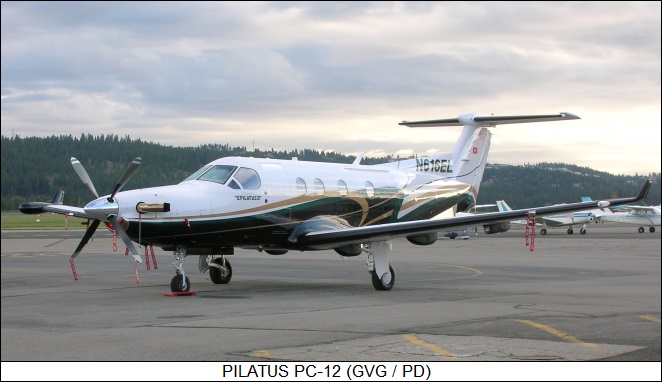
* The Morane-Saulnier company of France was a player in aviation from before the First World War. In 1962 Morane-Saulnier was bought out by Potez, which was bought out in turn in 1966 by Sud Aviation, later Aerospatiale -- the Morane-Saulnier unit being renamed "SOCATA", for "Societe de Construction d'Avions de Tourisme et d'Affaires (Company for the Construction of Aircraft for Tourism & Business)". SOCATA focused primarily on development and production of tidy light single-engine civil aircraft, such as the "TB" series -- named after the French city of Tarbes, where the SOCATA plant was located.
In the early 1980s, the US Mooney civil aircraft firm developed a six-seat piston single, the "Mooney 301". The 301 would never go beyond a single flight prototype, which performed its initial flight in 1983, but Mooney was bought out by French investors in 1985, leading to discussions between Mooney and SOCATA for development of a turboprop derivative. A joint venture was set up in 1987 to build the "TBM (Tarbes-Mooney)" turboprop, with initial flight of the first of three prototypes on 14 July 1988, certification following in 1990. Financial problems forced Mooney to withdraw from the program, but the aircraft retained the "TBM" designation.
* The initial production variant, the "TBM 700", provides a baseline for the series. The TBM 700 was an elegant aircraft, built mostly of aircraft aluminum alloy and steel, with some use of plastic and composites. It featured straight wings and tailplane, along with a swept tailfin featuring a forward fillet. Flight surfaces were conventional, with ailerons, elevators, rudder, trim tabs, and one-piece flaps; there was a spoiler forward of the outboard half of each flap. Flight controls were manual, except for electrically actuated trim tabs and flaps. There were twin fixed ventral fins under the tail. The TBM 700 had tricycle landing gear, all gear with single wheels, the nose gear retracting backward and the main gearing hinging in the wings towards the fuselage.
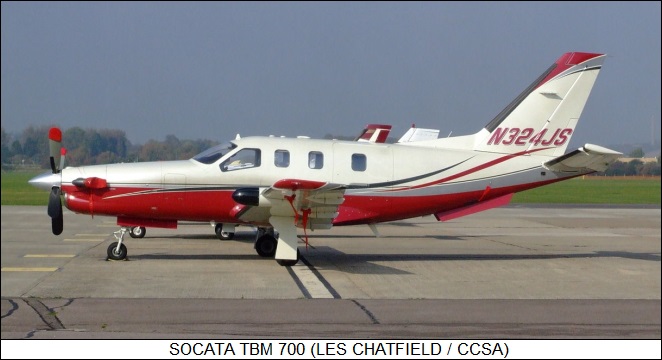
The TBM 700 was powered by a Pratt & Whitney Canada (PWC) PT6A-64 turboprop, with 522 kW (700 SHP), driving a four-bladed, fully reversible Hartzell propeller. There was a fuel tank in each wing, each tank with its own refueling point, the two tanks providing a total capacity of 1,080 liters (285 US gallons). The TBM 700 had pressurized and climate-conditioned accommodations, with seating for two pilots -- dual controls were standard -- and four passengers, the passengers facing each other front to back. Sources show diagrams of a high-density layout with five passenger seats, with three rows of seats and the middle row with one seat, but it doesn't seem to have been popular. Baggage storage was in the rear of the passenger cabin, and in an unpressurized baggage hold in the nose of the aircraft forward of the cockpit; sources seem to hint that the unpressurized hold was added in later production. There was a passenger-crew door on the left rear fuselage, the door being split up and down, with the lower segment featuring an "airstair".
___________________________________________________________________
SOCATA TBM 700:
___________________________________________________________________
wingspan:
12.16 meters (39 feet 11 inches)
wing area:
28 sq_meters (193.75 sq_feet)
length:
10.43 meters (34 feet 2 inches)
height:
3.99 meters (13 feet 1 inch)
empty weight:
1,825 kilograms (4,025 pounds)
MTO weight:
2,990 kilograms (6,595 pounds)
max cruise speed:
555 KPH (345 MPH / 300 KT)
service ceiling:
9,150 meters (30,000 feet)
take-off run:
865 meters (2,850 feet)
range:
2,985 kilometers (1,855 MI / 1,610 NMI)
___________________________________________________________________
The prop was electrically de-iced; the windscreen was de-iced both electrically and by bleed air; while all flight surfaces had pneumatic de-icing boots. Avionics were conventional, including radio, identification transponder, autopilot, and navigation system. The navigation system had a global positioning system (GPS) option. Weather radar was also available as an option, the radar being mounted in a fairing outboard on the leading edge of the left wing.
The split rear door was replaced in 1998 by a large upward-opening door with tilt-down steps. A quick-change configuration was available as an option, allowing the seats to be yanked for carrying cargo, the reinforced floor featuring tie-downs. Maximum cargo load was 825 kilograms (1,820 pounds). There was also a configuration with two instead of four passenger seats to permit more cargo carriage -- though it is unclear if this was a special option or, more likely, if it was just the standard configuration with the two rear seats removed. TBMs configured for cargo operations also featured an optional cockpit door on the left.
The TBM 700 was sold in a number of subvariants. Sources are notably confused and confusing in their descriptions, but it appears that the sequence was as follows:
The French Air Force and Army bought a total of 26 TBM 700s for liaison duties. Work on a stretched variant, the "TBM 700S", was abandoned in the mid-1990s. There was also a concept for a high-altitude surveillance / research derivative, the "SOCATA 60000", with greatly extended flight surfaces, but it never went beyond the paper stage.
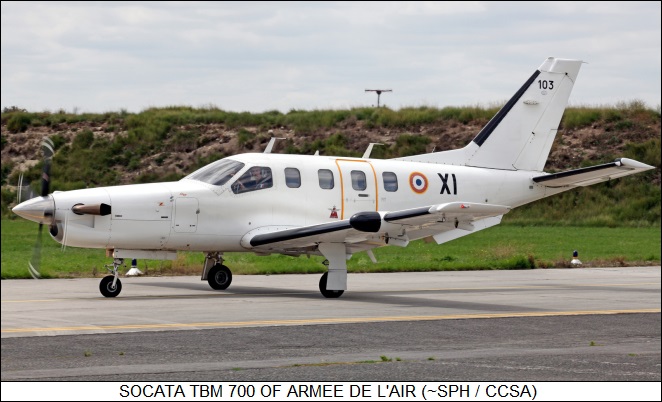
* SOCATA has of course refined the TBM:
SOCATA offered the TBM series in special mission configurations -- for air ambulance, photo survey, target tug, maritime patrol, surveillance, and electronic warfare (EW) missions. The company demonstrated a machine for photo survey, with a belly camera pack; has also demonstrated an air ambulance configuration; and has sold at least one "multimission" TBM, with a retractable imager turret under the rear fuselage, to Argentine security police.
Under the EcoPulse project Daher, Airbus and Safran flew a TBM 900 turboprop as a "distributed propulsion" demonstrator from 2022. The TBM retained its turboprop engine, but it had three small electrically-driven props on each wing, driven by a battery pack.
A total of over 1,150 TBMs has been sold to date. SOCATA became part of the European Aerospace & Defense Systems (EADS) group -- later the Airbus Group -- in 2000 when Aerospatiale was absorbed into the conglomerate, but the SOCATA operation was sold off to Daher in 2008, and so the aircraft is now the "Daher TBM".
BACK_TO_TOP* The Pilatus company of Switzerland was established shortly after the outbreak of World War II, at the outset focusing mostly on maintenance and assembly of existing aircraft types. The first aircraft of significance produced by Pilatus was the "P-2" piston trainer of 1945, followed early in the next decade by the improved "P-3" piston trainer. In the mid-1950s, Pilatus introduced the best-selling "PC-6 Porter" utility aircraft, and in the early 1970s introduced the similarly popular "PC-7" turbo trainer, derived from the P-3.
In the late 1980s, Pilatus began investigation of a turboprop-powered utility aircraft, only to find their efforts trumped by the popular Cessna Caravan. They shifted their sights to a turboprop business aircraft, formally launching the "PC-12" program in 1989. Initial flight of the prototype was on 31 May 1991. Trials going well, certification was obtained in 1994, with deliveries before the end of the year.
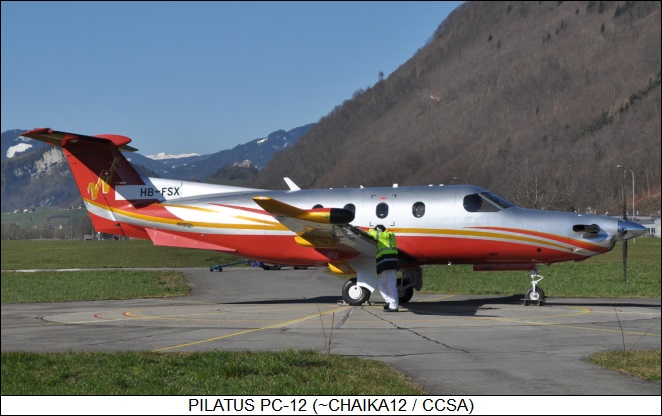
The PC-12, as introduced, had a low wing with winglets, a tee tail with a dorsal fillet, and tricycle landing gear -- hydraulically activated, all single wheels, the steerable nose gear retracting back, the main gear retracting in from the wings. It was powered by a PWC PT6A-67B turboprop, providing 1,200 kW (1,605 SHP) and driving a four-bladed Hartzell propeller. The PC-12 was mostly made of aircraft metal but had some composite parts, such as the winglets. The flight surfaces were pneumatically de-iced, while the windscreen and prop were electrically de-iced.
___________________________________________________________________
PILATUS PC-12:
___________________________________________________________________
wingspan:
16.08 meters (52 feet 9 inches)
wing area:
25.8 sq_meters (277.8 sq_feet)
length:
14.38 meters (47 feet 2 inches)
height:
4.26 meters (14 feet)
empty weight:
2,386 kilograms (5,260 pounds)
MTO weight:
4,000 kilograms (8,820 pounds)
max speed at altitude:
500 KPH (310 MPH / 270 KT)
service ceiling:
10,670 meters (35,000 feet)
take-off run:
680 meters (2,230 feet)
range:
3,310 kilometers (2,060 MI / 1,790 NMI)
___________________________________________________________________
An optional Honeywell weather radar pod could be fitted on the right wingtip. The aircraft had a fold-down airstair door on the left side of the fuselage, with a large upward-opening cargo door at the rear on the same side; there was an emergency exit above the wing on the right side. The PC-12 featured a reinforced floor for cargo hauling. Flight crew was one or two.
Various configurations have been offered:
* A variant of the PC-12 with gross weight increased from 4,000 to 4,500 kilograms (8,820 to 9,920 pounds) was certified in 1996; it became production standard in 1997, with this version known as the "PC-12/45". There was consideration in that timeframe of "PC-12/44" powered by twin Williams turbofans on wingtop pylons, but it didn't happen. Another improved variant with gross weight increased to 4,740 kilograms (10,450 pounds) was introduced in 2006, with the designation of "PC-12/47". The PC-12/47 could either handle 240 kilograms (530 pounds) more payload, or extend its range by 650 kilometers (400 miles / 350 NMI).
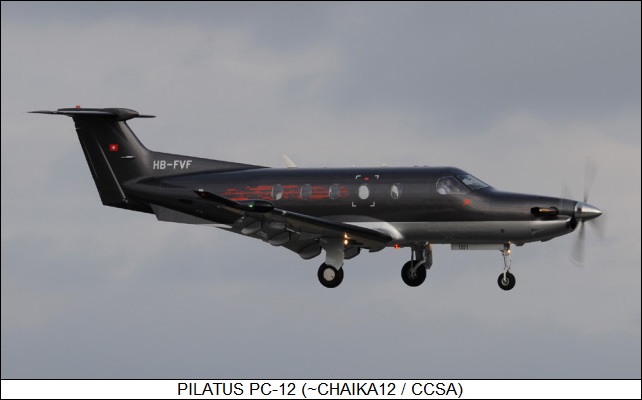
The "PC-12 Next Generation (NG)" was introduced in 2008, and featured;
Further refinements were introduced from 2008, such as:
The PC-12 NG was followed in 2020 by the "PC-12 NGX", with a redesigned cabin, bigger windows, an updated Honeywell glass cockpit, and a PWC PT6E-67XP engine with a dual channel engine / prop controller. The control system monitored the engine in detail, maintaining a record that could be downloaded via wireless on landing. The PT6E-67XP provided higher cruise speed, as well as lower noise and reduced operating costs.
Upgrade packages are available to modernize older PC-12s to glass cockpits and other refinements. By 2023, over 2,000 PC-12s of all types had been delivered. A "PC-12 PRO" was announced in 2025, with an updated cockpit featuring a Garmin G3000 flight deck, plus an updated interior.
* The PC-12 has been obtained by military and paramilitary services as a utility aircraft. In 1995 Pilatus announced a "multi-mission" variant of the PC-12 for surveillance, environmental survey, aerial mapping, and so on. This variant was originally named "PC-12 Eagle", but later became known as the "PC-12M". The PC-12M featured an uprated electrical power generation system to support sensor or other payloads, plus a quick-change interior to permit flexible mission support.
The initial PC-12M demonstrator flown in 1995 featured a Raytheon Sea Vue synthetic aperture radar (SAR) in a centerline belly "canoe" fairing with an electro-optic / infrared (EO/IR) turret at the front of the pod, plus a digital datalink system. Two more demonstrators were flown, with one ending up being used by the Swiss for trials. There was little interest in the concept in the 1990s, and the PC-12M effort got the axe in 2002.
It was promptly revived in 2003 in a new configuration as the "PC-12 Spectre", which in development featured a retractable EO/IR turret under the rear fuselage and twin workstations, plus a digital video recorder and a military communications / datalink system. Of course, the Spectre is now being offered with PC-12 NG flight systems; other gear, such as a SAR or defensive countermeasures, can be added at customer request.
Upgrades from transport PC-12s to Spectre configuration are also available from third parties. The Spectre has proven more successful than the Eagle, with users including Argentina, Bulgaria, Ireland, Switzerland, and the US Department of Homeland Security (USDHS). The USDHS has at least three, being flown for border patrol.
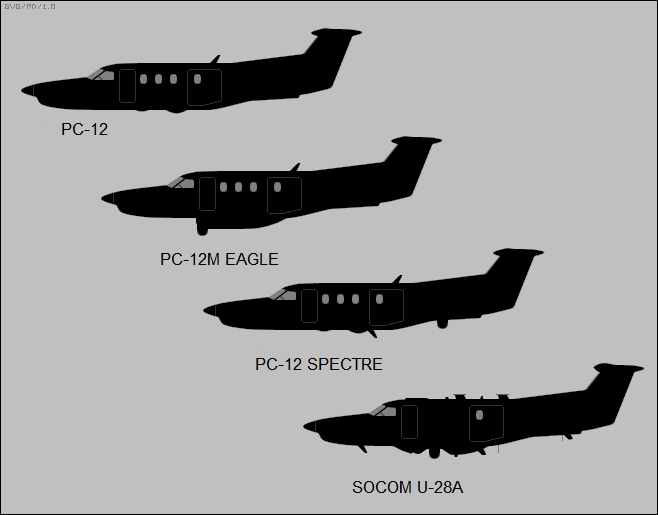
One prominent user of the PC-12 is the US Air Force Special Operations Command (AFSOC), which obtained at least three dozen of the type from 2005 as the "U-28A Draco". The AFSOC likes it for its capability, performance, and ability to operate from rough fields. Some photos of U-28A machines show them as "slick", close to stock configuration, with no more than an additional antenna or two, presumably for military communications; others have a "farm" of antennas, including one in an expanded fairing at tailplane-tailfin joint, and belly canoes in at least two configurations, one with an imager turret. Given the litter of antennas, U-28As may also carry signals intelligence gear; most or all have defensive countermeasures systems as well. They do not appear to be armed.
These aircraft are sometimes painted in civilian-style liveries with subdued national markings, so they can operate in foreign countries without drawing too much attention to themselves. One was lost in a crash in Djibouti in early 2012, with all four aircrew killed, hinting at the US secret war against Islamists in the Horn of Africa.
A total of 18 PC-12 / U-28A machines was also ordered by Afghanistan, working with the US military, with the first of these aircraft delivered in late 2013. They were described as having been fitted with a "very basic" surveillance system; they were followed in 2015 by five more PC-12s, with a signals intelligence system. What happened to them after the fall of Afghanistan in 2021 is not clear; some may have escaped, with hints of them being flown in service of anti-Taliban resistance groups.
BACK_TO_TOP* A number of other single turboprop executive aircraft have been built, but none have achieved the success of the TBM or PC-12 so far. In the mid-1990s the Myasishchev organization of Russia introduced the "M-101T", a machine with a general configuration along the lines of the TBM, if somewhat boxier in appearance, but only a handful were sold.
From 2000, the Czech Aero Vodochody firm also worked on an eight-seat turboprop single, the "Ae 270 Ibis / Spirit", that was very much along the lines of the PC-12. Eight were built, in collaboration with Taiwan Aerospace Industrial Development, but the project was canceled in 2007. There was later talk of restarting the project, but nothing much then happened.
A more recent contender is the "Epic 1000" of Epic Air LLC, based in the US state of Oregon. It began life as the "Epic LT", which performed its initial flight in 2004. It was of the same general configuration as the TBM and PC-12 -- a low-wing monoplane with retractable tricycle landing gear, powered by a single turboprop engine -- but was only available in a luxury passenger configuration, there being no option for a big cargo door; it was also mostly made of carbon composite material, and appropriately had a very sleek configuration.
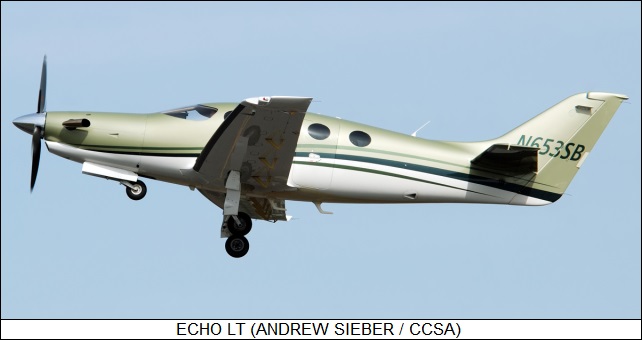
Wingspan was 13.1 meters (43 feet), length was 11.2 meters (36 feet 10 inches), and empty weight was 2 tonnes (4,400 pounds). Standard powerplant was the PWC PT6A-67 with 895 kW (1,200 SHP) and driving a Hartzell propeller, providing a top cruise speed of 600 KPH (375 MPH / 325 KT). Several users built them as kits, flying them as experimentals. The firm went bankrupt in 2009, but it rose from the dead via a buyout and reorganization; it refined the Epic LT as the 1000, with initial flight in its new configuration on 19 December 2015. Certification was in late 2019, with deliveries following of an improved "Epic 1000 GX" configuration. Eighty had been built by 2024.
The Piper "PA-46 Malibu" turboprop executive aircraft also should be mentioned here, but since the family includes piston variants, it needs to be discussed elsewhere. Beech Textron is now developing a turbo single under the Beechcraft label, the "Denali", very much in the class of -- and with a strong resemblance to -- the PC-12, first flight being planned for 2018. It will be powered by the GE Catalyst / Advanced Turboprop (ATP) with 925 kW (1,240 SHP), and feature a Garmin touchscreen glass cockpit. Weather radar will be standard, as will a terrain warning system. First flight was delayed by problems with the Catalyst engine, but it finally took place in 2023, with certification in 2025 and deliveries to start in 2026.
* This item was mostly derived from examinations of various editions of JANE'S ALL THE WORLD'S AIRCRAFT, manufacturer websites, and such small commentaries as I could find elsewhere. Finding much detail on the SOCATA TBM was particularly difficult, variant descriptions being a real headache.
* Revision history:
v1.0.0 / 01 apr 13 / PC-12 originally part of Cessna Caravan document. v1.0.1 / 01 apr 14 / Minor tweaks. v1.0.2 / 01 mar 16 / TBM 900, Epic 1000 update. v1.0.3 / 01 feb 18 / TBM 930. v1.1.0 / 01 jan 20 / PC-12 NGX. v1.2.0 / 01 nov 21 / Review & polish. v1.2.1 / 01 oct 23 / Review, update, & polish. v1.2.2 / 01 oct 25 / Review & polish.BACK_TO_TOP
